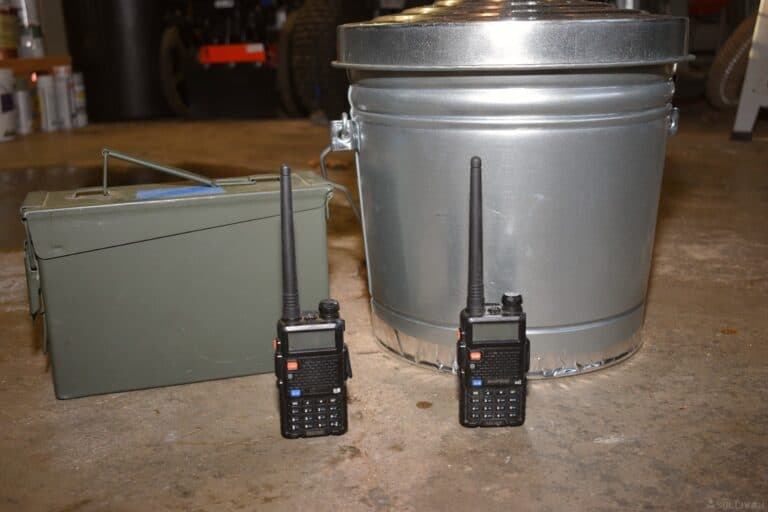

One of the very best things you can do for yourself when it comes to ensuring you have continuity of communications in times of trouble is to take up amateur radio, often called ham radio.
Completely self-contained, as long as your set is powered, you can broadcast and receive from anyone else that’s out there as long as they’re within range.
Old fashioned compared to cell phones, yes, but still incredibly useful and also a worthwhile hobby in and of itself. However, talking on the radio is an entirely different exercise compared to talking on the phone.
There are strict rules of procedure and etiquette that must, or should, be followed if you want to show respect and get it in turn. I’ll tell you about nine of the most important radio etiquette rules to always remember below.
Respect Frequency Rights
This is a big one, and one that I see beginning ham ops run afoul of from time to time, often to their embarrassment.
You must remember that the FCC has split shared band users into two categories: primary and secondary.
As you might expect, users in the primary category have priority and right-of-way when using these shared bands. Secondary users can only use them at all when they aren’t being used by primary users.
For instance, 219-220 megahertz is typically used as a marine traffic frequency. They are the primaries, and they have right-of-way. Secondary users, for whatever purpose, can only use those frequencies when they aren’t being used by marine users.
Don’t make the mistake of hopping on there and trying to claim you were there first when a primary user comes along. You’ll be corrected harshly and immediately, and rightfully so!
The only exception to this rule is if you have legitimate emergency reasons for being on the channel at that time. We’ll talk more about that in just a bit…
Be Mindful of the Time
Pay attention to the time when you’re trying to transmit and talk on your radio, especially if you just want to have a long conversation, what’s known as a ragchewing session in ham parlance.
As you might expect, traffic increases precipitously on the weekends, at least in the United States, when the work week is over. But if you’re transmitting anytime during the week, especially during the middle of the day, there will be a lot less traffic assuming all things are equal.
You don’t know what people will be doing on the radio waves on the weekends, and so your usual channels for chatting with a friendly and regular contact might be covered up. Don’t be afraid to reschedule or move to a different channel, and be prepared to look to find some clear air.
Know When and How to Break In
When you tune to a channel, for whatever reason, don’t just start talking out of the blue.
Stop, wait, and listen to see if anyone else is already using the channel or having a conversation of their own.
I like to wait about 5 minutes to be sure. If someone is talking, make sure you note any call signs that you hear and pay attention to see if it is a conversation that they might want other people to jump in on. They might not!
If you know the channel is clear or you have an opportunity to jump in, key the mic and announce yourself using your call sign per usual with proper phonetic alphabet. Include your name and location if desired or required.
After announcing yourself, state your intentions for why you are on the channel or ask if you can join the conversation. Done courteously like this, others that are on the frequency should let you know politely if it’s okay or not.
Don’t Talk Over People
This one should be obvious, but you’d be surprised how many people get on the air with a ham radio after coming over from CB or something else and just turn into ratchet jaws, stepping on people left and right.
Don’t talk over anyone deliberately, and if you do accidentally, just stop transmitting and apologize later so you don’t completely foul up the conversation. If you have an honest emergency, call for a break, but otherwise never transmit over someone.
Know Which Frequencies You Shouldn’t Chat On
If you’re just wanting to casually chat with people or find distant contacts on the radio, know what frequencies to dial into to accomplish that.
The trick is, there aren’t really official frequencies for doing so, but there are rules of thumb for avoiding popularly used frequencies for the purpose.
Your best bet is simply to avoid those that are often used for specific purposes at specific times, like DXing, Morse code, club activities, and more.
There are differences at the local, regional, and national level also, with ham clubs and competitions occupying certain frequencies at certain times of the week, month, and year.
It pays to be in the loop for this sort of thing so you can avoid clogging up airwaves and making people angry. Signing up with the ARRL, state, and local clubs is a great way to stay abreast of this activity.
Learn the Lingo
More basics, but you’d be surprised how many ham operators go for a long time without getting this stuff under their belt.
Learn the phonetic alphabet, your Q-codes, lingo, slang, and everything else so you can interpret conversations quickly, and also maintain brevity while on the air.
It’s okay if you’re new and a little slow or unsure of yourself. Everyone started somewhere, and most veteran radio operators will be happy to help you along and be patient. But there’s no excuse for staying a newbie forever.
Be Aware of Emergency or Professional Traffic
This is a biggie. Always, always be alert for the presence of emergency or professional radio traffic, and clear the air right away when you notice it.
Aside from being Federal law, minutes matter when lives or property are on the line, so don’t screw around. Note that this also applies to vetted amateur operators on official or volunteer business, like those belonging to ARES.
CQ Correctly
This is a subtle one, and one that’s easy to get tripped up on…
If you want to reach out to someone to chat with who might be monitoring the frequency, you can’t just broadcast asking if anyone’s out there who would like to talk. That’s broadcasting, and not allowed if you recall the rules and regulations you were tested on.
You need to do it correctly, and that means you need to say your call sign followed by “monitoring” if you are communicating via a local repeater, or else announce CQ, a code that asks if anyone is monitoring the frequency and would like to talk.
Simply announce CQ three times, followed by your call sign, and wait for an answer.
Always Identify and Sign Off Properly
Another “gotcha” that new ham-ops often forget. You must identify yourself at least every 10 minutes while on the air, and at the end of a communication by using your call sign.
This isn’t just good manners, no, it is, but it’s also a legal requirement. If you don’t identify yourself periodically while on the air, even in the midst of a conversation, you are conducting an illegal unidentified transmission.
If you are DXing or chatting with someone in another country, you must still identify yourself in English no matter what other languages you speak or what your contact is speaking.


Tom Marlowe practically grew up with a gun in his hand, and has held all kinds of jobs in the gun industry: range safety, sales, instruction and consulting, Tom has the experience to help civilian shooters figure out what will work best for them.




